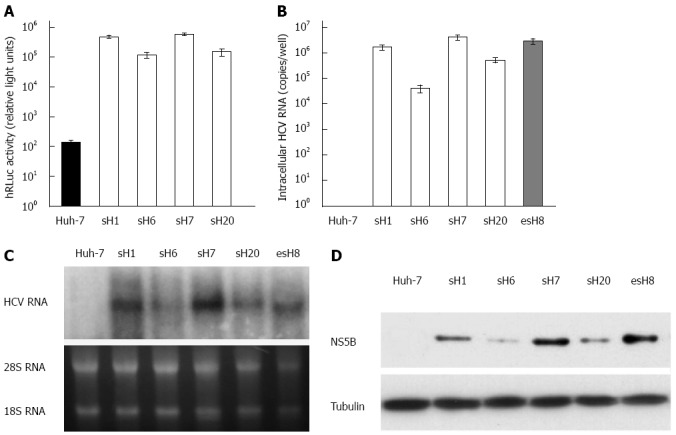Figure 3.

Characterization of the tricistronic hepatitis C virus replicon. A: Transgene expression in cells stably transfected with tricistronic hepatitis C virus (HCV) replicon. Fifty stable cell clones were screened with G418 from Huh-7 cells transfected with the purified tricistronic HCV replicon RNA. The humanized Renilla luciferase (hRLuc) activity in sH7 cells was the highest among all of the surviving cell clones; B: HCV RNA in cells stably transfected with tricistronic HCV replicon. HCV RNA in four strains with the highest level of hRLuc activity was quantified by real-time PCR. Huh-7 cells were also transfected with pUC19-HCV and screened to form stable clones as a reference, namely esH8 after the encephalomyocarditis virus internal ribosome entry site (IRES). HCV RNA was amplified from all the tricistronic replicons strains, especially in sH7 clones, in which HCV RNA copy number was higher than any other strains and parental Huh-7 cells. HCV RNA levels in sH7 cells was even more than that in esH8, the pUC19-HCV stably transfected cells; C: Replication of HCV replicons in cells stably transfected with tricistronic HCV replicon. RNA replication was seen in all the tricistronic replicons strains, especially in sH7 clones, in which HCV RNA level was significantly higher than that of parental Huh-7 cells and even higher than that of esH8. The esH8 cells harboring pUC19-HCV replicon with NeoR gene directed by HCV IRES were also used as a reference; D: HCV non-structural gene expression in cells stably transfected with tricistronic HCV replicon. NS5B was probed in four strains with the highest level of hRLuc activity and esH8 cells by Western blot. HCV NS5B protein was found in four tricistronic replicon clones, especially in sH7 clones with the highest NS5B level. NS5B in sH7 cells was comparable to that in esH8 cells.
